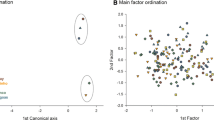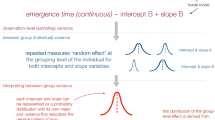Abstract
Endosymbiotic association is frequent in insects, and endosymbionts influence a range of biological processes in these organisms. The endosymbiont–insect association and interdependence allegedly result from random selection where ecological trade-offs take place and usually differ between the involved species. Insect behavior is potentially affected by this association, but the focus in such studies is symbiont presence rather than load, and overall behavioral patterns, not the individual set of integrated behavioral tendencies (i.e., individual personality). This knowledge gap limits the understanding of how the endosymbiont–insect association affects insect behavior and how this translates into fertility, as a measure of fitness. Here, we assessed the endosymbiont load of maize weevils [Sitophilus zeamais Motschulsky (Coleoptera: Curculionidae)], which hosts two symbiont species—Sodalis pierantonius and Wolbachia, and their association with weevil personality and reproductive consequences. Thus, individual female weevils were subjected to oral administration of antibiotics (ciprofloxacin and tetracycline) to secure a range of symbiont loads, which were quantified by qPCR. Individual personality of these females was recorded before and after endosymbiont suppression, and also that of their progeny. Female weevils maintained their personality with symbiont suppression, which was not transferred to their progeny. Nonetheless, personality itself was more important in determining female reproductive output than endosymbiont load, which did not significantly alter individual integrated behavior. Thus, management tactics targeting endosymbiont suppression may not be as effective as initially anticipated, unless complete suppression of the obligatory symbiont S. pierantonius takes place.


Similar content being viewed by others
References
Branlatschk R, Bodenhausen N, Zeyer J, Burgmann H (2012) Simple absolute quantification method correcting for quantitative PCR efficiency variations for microbial community samples. Appl Environ Microbiol 78:4481–4489. https://doi.org/10.1128/AEM.07878-11
Bolívar-Silva DA, Guedes NMP, Guedes RNC (2018) Larval cannibalism and fitness in the sotred grain weevils Sitophilus granaries and Sitophilus zeamais. J. Pest Sci 91:707–716. https://doi.org/10.1007/s10340-017-0921-5
Bourtzis K (2008) Wolbachia-based technologies for insect pest population control. In: Aksoy S (ed) Transgenesis and the management of vector-borne disease. Springer, New York, pp 104–113. https://doi.org/10.1007/978-0-387-78225-6_9
Carvalho GA, Corrêa AS, Oliveira LO, Guedes RNC (2014a) Evidence of horizontal transmission of primary and secondary endosymbionts between maize and rice weevils (Sitophilus zeamais and Sitophilus oryzae) and the parasitoid Theocolax elegans. J Stored Prod Res 59:61–65. https://doi.org/10.1016/j.jspr.2014.05.004
Carvalho GA, Vieira JL, Haro MM, Corrêa AS, Ribon AOB, de Oliveira LO, Guedes RNC (2014b) Pleiotropic impact of endosymbiont load and co-occurrence in the maize weevil Sitophiluszeamais. PLoS ONE 9:e111396. https://doi.org/10.1371/journal.pone.0111396
Carvalho GA, Corrêa AS, Oliveira LO, Chediak M, Siqueira HAA, Guedes RNC (2018) Wolbachiastrains, and lack of genetic diversity and parthenogenesis in Brazilian populations of Tuta absoluta. J Appl Entomol 142:905–910. https://doi.org/10.1111/jen.12531
Chiel E, Zchori-Fein E, Inbar M, Gottlieb Y, Adachi-Hagimori T, Kelly SE, Asplen MK, Hunter MS (2009) Almost there: transmission routes of bacterial symbionts between trophic levels. PLoS ONE 4(3):e4767. https://doi.org/10.1371/journal.pone.0004767
Cordeiro EMG, Corrêa AS, Rosi-Denadai CA, Tomé HVV, Guedes RNC (2017) Insecticide resistance and size assortative mating in females of the maize weevil (Sitophilus zeamais). Pest Manag Sci 73:823–829. https://doi.org/10.1002/ps.4437
Corrêa AS, de Oliveira LO, Braga LS, Guedes RNC (2013) Distribution of the related weevil species Sitophilus oryzae and S. zeamais in Brazil. Insect Sci 20:763–770. https://doi.org/10.1111/j.1744-7917.2012.01559.x
Corrêa AS, Vinson CC, Braga LS, Guedes RNC, de Oliveira LO (2017) Ancient origin and recent range expansion of the maize weevil Sitophilus zeamais, and its genealogical relationship to the rice weevil S. oryzae. Bull Entomol Res 107:9–20. https://doi.org/10.1017/S0007485316000687
Douglas AE (1998) Nutritional interactions in insect-microbial symbioses: aphids and their symbiotic bacteria Buchnera. Annu Rev Entomol 43:17–37. https://doi.org/10.1146/annurev.ento.43.1.17
Douglas AE (2015) Multiorganismal insects: diversity and function of resident microorganisms. Annu Rev Entomol 60:17–34. https://doi.org/10.1146/annurev-ento-010814-020822
Eiseke I, Meyhöfer R (2015) Adding personality to biocontrol: characterization and suitability of microsatellites for sibship reconstruction in the aphid parasitoid Diaeretiella rapae. Biocontrol 60:189–197. https://doi.org/10.1007/s10526-014-9643-2
Fragoso DB, Guedes RNC, Peternelli LA (2005) Developmental rates and population growth of insecticide-resistant and susceptible populations of Sitophilus zeamais. J Stored Prod Res 41:271–281. https://doi.org/10.1016/j.jspr.2004.03.008
Gasnier-Fauchet F, Nardon P (1987) Comparison of sarcosine and methionine sulfoxide levels in symbiotic larvae of two sibling species, Sitophilus oryzae L. and S. zeamais Mots. (Coleoptera: Curculionidae). Insect Biochem Mol Biol 17:17–20. https://doi.org/10.1016/0020-1790(87)90138-7
Guedes NMP, Guedes RNC, Campbell JF, Throne JE (2010) Contest behaviour of maize weevil larvae when competing within seeds. Anim Behav 79:281–289. https://doi.org/10.1016/j.anbehav.2009.10.022
Guedes NMP, Braga LS, Rosi-Denadai CA, Guedes RNC (2015) Desiccation resistance and water balance in populations of the maize weevil Sitophilus zeamais. J Stored Prod Res 64:146–153. https://doi.org/10.1016/j.jspr.2014.09.009
Guedes NMP, Guedes RNC, Campbell JF, Throne JE (2017) Mating behavior and reproductive output in insecticide-resistant and—susceptible strains of the maize weevil (Sitophilus zeamais). Ann Appl Biol 170:415–424. https://doi.org/10.1111/aab.12346
Heddi A, Lefebvre F, Nardon P (1993) Effect of endocytobiotic bacteria on mitochondrial enzymatic activities in the weevil Sitophilus oryzae (Coleoptera: Curculionidae). Insect Biochem Mol Biol 23:403–411. https://doi.org/10.1016/0965-1748(93)90024-M
Heddi A, Grenier AM, Katchadourian C, Charles H, Nardon C (1999) Four intracellular genomes direct weevil biology: nuclear, mitochondrial, principal endosymbiont, and Wolbachia. PNASS 96:6814–6819. https://doi.org/10.1073/pnas.96.12.6814
Heddi A, Charles H, Katchadourian C (2001) Intracellular bacterial symbiosis in the genus Sitophilus: the “biological individual” concept revisited. Res Microbiol 152:431–437. https://doi.org/10.1016/S0923-2508(01)01216-5
Heddi A, Vallier A, Anselme C, Xin H, Rahbe Y, Wäckers (2005) Molecular and cellular profiles of insect bacteriocytes: mutualism and harm at the initial evolutionary step of symbiogenesis. Cell Microbiol 7:293–305. https://doi.org/10.1111/j.1462-5822.2004.00461.x
Hurst LD, Randerson JP (2002) Parasitic sex puppeteers. Sci Am 286:42–47. https://doi.org/10.1038/scientificamerican0402-56
Kageyama D, Narita S, Imamura T, Miyanoshita A (2010) Detection and identification of Wolbachia endosymbionts from laboratory stocks of stored-product insect pests and their parasitoids. J Stored Prod Res 46:13–19. https://doi.org/10.1016/j.jspr.2009.07.003
Kralj-Fiser S, Schuett W (2014) Studying personality variation in invertebrates: why bother? Anim Behav 91:41–52. https://doi.org/10.1016/j.anbehav.2014.02.016
Kikuchi Y, Hayatsu M, Hosokawa T, Nagayama A, Tago K, Fukatsu T (2012) Symbiont-mediated insecticide resistance. PNAS 109:8618–8622. https://doi.org/10.1073/pnas.1200231109
Le Clec’h W, Chevalier FD, Genty L, Bertaux J, Bouchon D, Sicard M (2013) Cannibalism and predation as paths for horizontal passage of Wolbachia between terrestrial isopods. PLoS ONE 8(4):e60232. https://doi.org/10.1371/journal.pone.0060232
Malia HAE, Rosi-Denadai CA, Cardoso DG, Guedes RNC (2016) Dust to weevils, weevils to dust: maize weevil personality and susceptibility to diatomaceous earth. J Pest Sci 89:469–478. https://doi.org/10.1007/s10340-015-0713-8
Morales JA, Cardoso DG, Della Lucia TMC, Guedes RNC (2013) Weevil × insecticide: does ‘personality’ matter? PLoS ONE 8:e67283. https://doi.org/10.1371/journal.pone.0067283
Moran NA (2006) Symbiosis. Curr Biol 16:R866–R871. https://doi.org/10.1016/j.cub.2006.09.019
Moran NA, McCutcheon JP, Nakabachi A (2008) Genomics and evolution of heritable bacterial symbionts. Ann Rev Gen 42:165–190. https://doi.org/10.1146/annurev.genet.41.110306.130119
Morera-Margarit P, Pope TW, Mitchell C, Karley AJ (2020) Could bacterial associations determine the success of weevil species? An Appl Biol. https://doi.org/10.1111/aab.12625
Nardon P, Grenier AM (1988) Genetical and biochemical interactions between the host and its endocytobiotes in the weevils Sitophilus (Coleoptera: Curculionidae) and other related species. In: Scannerini S, Smith D, Bonfante-Fasolo P, Gianinazzi-Pearson V (eds) Cell to cell signals in plant, animal and microbial symbiosis. Springer, Berlin, pp 255–270
Pilon FM, Visôtto LE, Guedes RNC, Oliveira MGA (2013) Proteolytic activity of gut bacteria isolated from the velvet bean caterpillar Anticarsia gemmatalis. J Comp Physiol B 183:735–747. https://doi.org/10.1007/s00360-013-0744-5
Réale D, Reader SM, Sol D, McDougall PT, Dingemanse NJ (2007) Integrating animal temperament within ecology and evolution. Biol Rev 82:291–318. https://doi.org/10.1111/j.1469-185X.2007.00010.x
Rodrigues AS, Botina L, Nascimento CP, Gontijo LM, Torres JB, Guedes RNC (2016) Ontogenic behavioral consistency, individual variation and fitness consequences among lady beetles. Behav Proc 131:32–39. https://doi.org/10.1016/j.beproc.2016.08.003
Russell JA, Moran NA (2005) Horizontal transfer of bacterial symbionts: heritability and fitness effects in a novel aphid host. Appl Environ Microbiol 71:7987–7994. https://doi.org/10.1128/AEM.71.12.7987-7994.2005
Saridaki A, Bourtzis K (2009) Wolbachia-induced reproductive parasitism and applications. Entomol Hell 18:3–16. https://doi.org/10.12681/eh.11597
Saridaki A, Bourtzis K (2010) Wolbachia: more than just a bug in insect genitals. Curr Opin Microbiol 13:67–72. https://doi.org/10.1016/j.mib.2009.11.005
Silva AA, Braga LS, Corrêa AS, Holmes VR, Johnston JS, Oppert B, Guedes RNC, Tavares MG (2018) Comparative cytogenetics and derived phylogenetic relationship among Sitophilusgrain weevils (Coleoptera, Curculionidae, Dryophthorinae). Comp Cytogen 12:2223–2245. https://doi.org/10.3897/CompCytogen.v12i2.26412
Stouthamer R, Breeuwer JAJ, Hurst GDD (1999) Wolbachia Pipientis: microbial manipulator of arthropod reproduction. Ann Rev Microbiol 53:71–102. https://doi.org/10.1146/annurev.micro.53.1.71
Su Q, Zhou X, Zhang Y (2013) Symbiont-mediated functions in insect hosts. Commun Integr Biol 6(3):e23804. https://doi.org/10.4161/cib.23804
Toju H, Tanabe AS, Notsu Y, Sota T, Fukatsu T (2013) Diversification of endosymbiosis: replacements, co-speciation and promiscuity of bacteriocyte symbionts in weevils. ISME J 7:1378–1390. https://doi.org/10.1038/ismej.2013.27
Turchen LM, CosmeL GRNC (2018) Bidirectional selection of walking velocity, associated behavioral syndrome and reproductive output in the maize weevil Sitophilus zeamais. J Pest Sci 91:1063–1071. https://doi.org/10.1007/s10340-018-0970-4
Uher J (2011) Individual behavioral phenotypes: an integrative metatheoretical framework. Why “behavioral syndromes” are not analogs of “personality”. Dev Psychobiol 53:521–548. https://doi.org/10.1002/dev.20544
Vigneron A, Masson F, Vallier A, Balmand S, Rey M, Vincent-Monégat C, Aksoy E, Aubailly-Giraud E, Zaidman-Rémy A, Heddi A (2014) Insects recycle endosymbionts when the benefit is over. Curr Biol 24:2267–2273. https://doi.org/10.1016/j.cub.2014.07.065
Visôtto LE, Oliveira MGA, Guedes RNC, Ribon AOB, Good-God PIV (2009) Contribution of gut bacteria to digestion and development of the velvetbean caterpillar, Anticarsia gemmatalis. J Insect Physiol 55:185–191. https://doi.org/10.1016/j.jinsphys.2008.10.017
Werren JH, Baldo L, Clark ME (2008) Wolbachia: master manipulators of invertebrate biology. Nat Rev Microbiol 6:741–751. https://doi.org/10.1038/nrmicro1969
Wicker C (1983) Differential vitamin and choline requirements of symbiotic and aposymbiotic S. oryzae (Coleoptera, Curculionidae). Comp Biochem Phys A76:177–182. https://doi.org/10.1016/0300-9629(83)90311-0
Acknowledgements
Appreciation is expressed to Drs. K. Haddi and G. Carvalho for the suggestions and comments provided during the study. We acknowledge the financial support provided by Minas Gerais Foundation for Research Aid (FAPEMIG), CAPES Foundation (Financial Code 001) and the National Council of Scientific and Technological Development (CNPq).
Funding
Financial support was provided by the Minas Gerais Foundation for Research Aid (FAPEMIG), CAPES Foundation (Brazilian Ministry of Education; Financial Code 001) and the National Council of Scientific and Technological Development (CNPq; Brazilian Ministry of Science and Technology).
Author information
Authors and Affiliations
Corresponding author
Ethics declarations
Conflict of interest
The authors declare no conflict of interest.
Consent for publication
All authors are in according to submission.
Additional information
Communicated by Antonio Biondi.
Publisher's Note
Springer Nature remains neutral with regard to jurisdictional claims in published maps and institutional affiliations.
Rights and permissions
About this article
Cite this article
Vieira, J.L., Guedes, R.N.C. Endosymbiont load, personality and reproductive output of maize weevils (Sitophilus zeamais). J Pest Sci 94, 691–701 (2021). https://doi.org/10.1007/s10340-020-01287-7
Received:
Revised:
Accepted:
Published:
Issue Date:
DOI: https://doi.org/10.1007/s10340-020-01287-7




